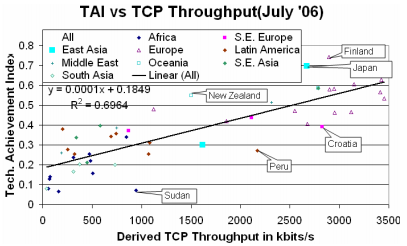An index introduced by the United Nations Development Programme (UNDP) is the Technology Achievement Index (TAI) 3 that reflects a country's capacity to participate in the technological innovations of the network age. The TAI aims to capture how well a country is creating and diffusing technology and building a human skill base. It includes the following dimensions: Creation of technology (e.g. patents, royalty receipts); diffusion of recent innovations (Internet hosts/capita, high & medium tech exports as share of all exports); Diffusion of old innovations (log phones/capita, log of electric consumption/capita); Human skills (mean years of schooling, gross enrollment in tertiary level in science, math & engineering). The latest TAI is 2001, so it is older than the HDI. Also the TAI is only available for 50 countries that we have PingER data and that are not in North or Central America, whereas the HDI is available for 96 such countries. Fig. 1 shows a scatter plot of TAI vs. TCP throughput. In this case both the metrics are technological in nature so a linear fit works well. The correlation is seen to be strong and there are fewer outliers than in the HDI case.
Figure 1: UNDP Technology Achievement Index (TAI) vs PingER Dervived THroughput
